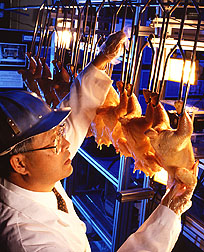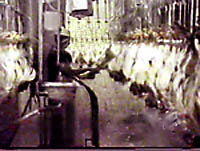You don’t have to be a vegetarian to appreciate the foulness of the U.S. Department of Agriculture’s proposed Poultry Rule. Many critics, including the Coalition for Sensible Safeguards, of which UCS is a member, have pointed out that the rule ignores evidence pertaining to human health and worker safety. Others have argued it is inhumane. The U.S. Government Accountability Office (GAO), in a report released earlier this year, found that the proposed rule is based on limited scientific data and inadequate evaluation of USDA pilot projects.
Admittedly, it isn’t an appetizing subject—in its details, more appropriate for a Halloween horror show than Thanksgiving dinner. But as millions of Americans are gearing up for a day of family, friends, and feasting, lawmakers on Capitol Hill have been pressuring USDA officials to move the proposed rule on to the Administration. Members of the House Agriculture Committee—Rep. Frank D. Lucas (R-Okla.), Rep. Collin C. Peterson (D-Minn.), Rep. Rick Crawford (R-Ark.), and Rep. Jim Costa (D-Calif.)—recently sent a letter to USDA secretary Tom Vilsack touting what they see as the rule’s merits and requesting a timeline for implementation. The latter two also serve on the Congressional Chicken Caucus, which provides a forum for the poultry industry to share its thoughts with Congress.
Supporters of the rule claim it will improve safety and efficiency at poultry processing plants, citing its purported effectiveness in the pilot projects currently ongoing in 20 chicken plants and five turkey plants. However, the Poultry Rule has significant flaws.
Compromised food safety
Although the rule was developed by the USDA Food Safety Inspection Service (FSIS) and its defenders contend it would prevent more than 5,000 annual foodborne illnesses in the U.S., many in the food safety community, including current and former USDA inspectors, disagree that it would make our food safer.
The rule would reduce the number of USDA inspectors working onsite by 75 percent and replace them with company employees who could face retribution from supervisors for slowing up the line with food safety concerns. In affidavits to the Government Accountability Project, USDA inspectors working on pilot project sites observed numerous instances of plant workers allowing birds tainted with fecal matter and other contaminants to pass.
The rule would also speed up slaughterhouse processing lines by 25 percent. This would mean not only fewer USDA inspectors to monitor contamination risks but less time to do it. In an era when multistate foodborne illness outbreaks are already on the rise, inspectors would have to work faster and would have less time to detect problems. With just a third of a second to examine each bird and the ability to see only one side of the bird instead of the whole animal, they would have more difficulty spotting bruises, blisters, tumors, pus, and other signs of disease.
Increased risks to workers
Workers in the poultry processing industry must cut, gut, scald, and de-feather birds as they fly by on automated machinery. Sometimes workers have less than a second to perform their tasks and have reported difficulty keeping up even at current speeds. It is exhausting, repetitive, low-paying, dangerous work, and mistakes can lead to serious injuries — not to mention excessive pain and suffering for the birds and resulting contamination of otherwise safe carcasses that have to be discarded (nearly a million a year) due to improper exsanguination and other problems.
According to the U.S. Occupational Safety and Health Administration (OSHA), workers in the poultry industry since 1975 have suffered injuries at a rate twice the national average. Frequent injuries include cuts and lacerations, slips and falls, and exposure to pathogens, toxic chemicals, and cold temperatures. Disabling injuries resulting in amputations and severe musculoskeletal disorders are not uncommon and can have life-altering consequences. The Poultry Rule will put workers at greater risk of incurring these injuries by further speeding up the rate at which they have to perform a variety of hazardous tasks.
The meat of the matter: A lack of scientific evidence
Whether you find human health, worker safety, animal welfare, or the waste of good food (an estimated 14 percent of Americans face food insecurity every year) most troubling, the Poultry Rule should make you clucking mad.
In his own letter to Secretary Vilsack, Sen. John Tester (D-Mont.) cited the GAO report as a good reason to postpone implementation of the rule until more data could be gathered and better analysis performed. Sen. Tester’s letter states:
“Without adequate scientific analysis to ensure the new process improves the safety of poultry slaughter and evisceration plants, it is premature to propose a rule that would standardize these practices across all plants … USDA should delay the proposed rule and reevaluate the pilot on food safety and market competition.”
As we prepare for a season of holiday dinners, we owe it to ourselves to think about where our food comes from and to ensure that science, not special interests, informs the policies governing how it gets to us.


